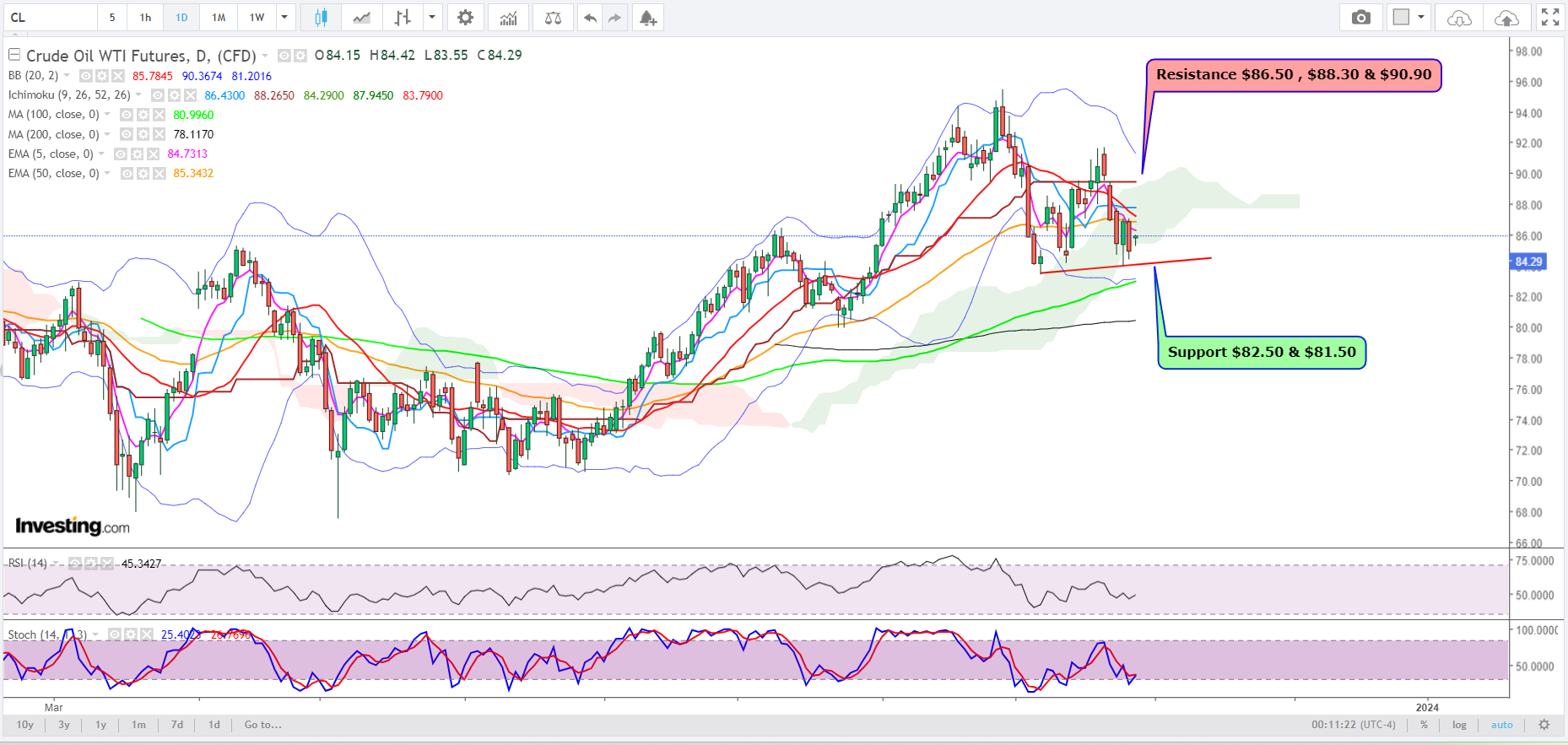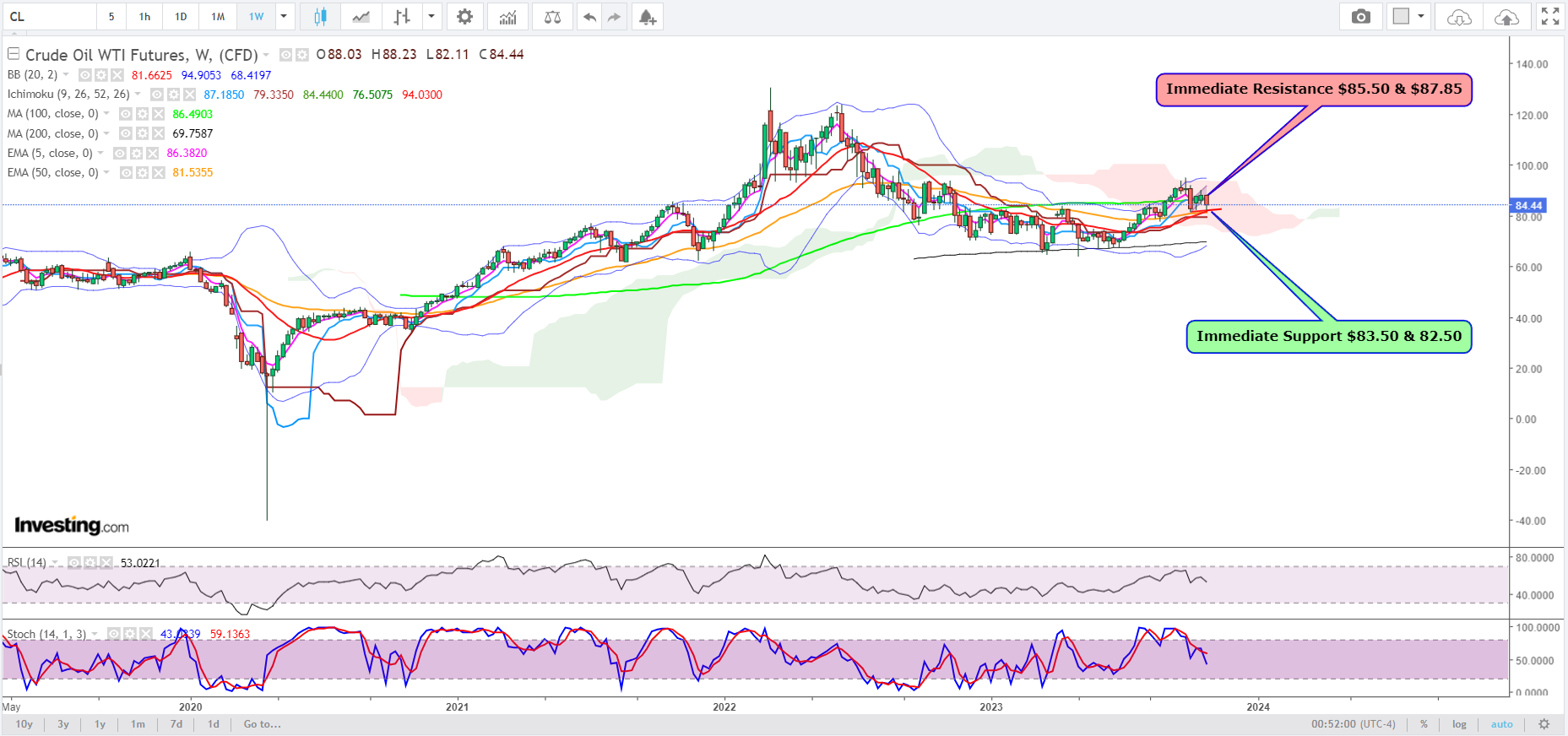- Flip-flops in oil’s war risk driving traders crazy as the world awaits to see if Israel will make next move on Gaza to flush out Hamas
- No one can say if WTI will reach $75 first on a de-escalation of the war, given the diplomatic efforts underway, or spike to $95 in the event of a grand assault starts
- There are almost an equal number of bullish and bearish drivers in oil now
The escalation and de-escalation of the Israel-Hamas war has led to on-again, off-again risk premium for oil
The three weeks of swings have been enough to exasperate some of the most hard-boiled crude traders.
After another three tumbles and two modest rebounds this week, the question, at least over the direction of a barrel of U.S. West Texas Intermediate was which will come first — $75 or $95?  All charts by SKCharting.com, with data powered by Investing.com
All charts by SKCharting.com, with data powered by Investing.com
Truth be told, it isn’t something anyone can answer at the moment; not when the momentum of the war is deciding for the larger part the momentum of the market.
WTI hovered at $84.50 per barrel at the time of writing, after Israeli Prime Minister Benjamin Netanyahu reiterated his commitment to a bigger ground assault on Gaza, following an overnight raid on the northern frontier of the territory.
That was after a day when signs of a potential de-escalation saw traders dialing down bets that the conflict would draw in other Middle Eastern countries and disrupt oil supplies in the crude-rich region.
Several diplomatic missions to Israel are also working 24/7 in delaying — or preventing altogether — Jerusalem’s planned no-holds-barred ground offensive against Gaza as negotiators try to secure the release of some 200 Israeli hostages held by Hamas.
Amid all these, you have daily economic data out of the US, China, and Europe — three of the world’s biggest oil-consuming centers — along with the incessant chatter of Federal Reserve officials, which can send the US dollar and Treasury yields spiking or plunging at any time; and weekly petroleum consumption/builds data out of the United States.
The chances of correctly calling the half-time score at the next Super Bowl is probably higher than reading oil’s tea leaves accurately now to make a precise strike on barrel pricing.
What traders have before them are, of course, chart projections on where the market could be headed with each price point.
Before we examine those — to determine the flag posts for the next rally or selloff — let’s list the bull case and bear case for oil and see how they stack up in tipping the market either way.
BULL CASE
- Gaza Ground Offensive:
An all-out ground offensive on Gaza by Israeli forces would likely provide the spark for $90 and above WTI pricing, especially if hostilities are sustained over an extended period and contagion develops from the war, ultimately impacting the Middle East’s oil traffic.
- Global Oil Squeeze:
US waterborne imports of crude from OPEC+ members, including Saudi Arabia, have dropped steadily over the last year, further tightening supplies in the United States while supporting other markets including Europe, according to flows data and analysts.
Lower US imports coincide with supply cuts by the Organization of the Petroleum Exporting Countries, Russia, and other allies, and extra voluntary curbs from Saudi Arabia and Russia of a combined 1.3 million bpd until the end of 2023.
The decision by Saudi Arabia and Russia to extend the voluntary cuts drove up oil prices to over $90 a barrel in late September. The cuts also tightened supplies of crude, particularly sour grades, ahead of the winter heating season.
Total US crude waterborne imports are set to average 2.47 million barrels per day in October, down from 2.92 million bpd in September according to figures from data intelligence firm Kpler, with shipments falling from OPEC+ producers including Nigeria, Algeria and Saudi Arabia.
Within that, Saudi crude exports to the US are set to drop to 241,000 bpd in October, Kpler figures showed, down from 286,000 bpd in September and from 410,000 bpd in October 2022.
Some of the decrease is linked to the change of seasons. US peak gasoline demand winds down at the end of summer as refineries slow operations for maintenance. But there are other reasons for the fall, analysts said.
Saudi Arabia "by keeping barrels away from the US, is influencing sentiment, keeping inventories in check, and ultimately influencing pricing," Matt Smith, lead oil analyst for the Americas at Kpler, said in comments carried by Reuters.
Instead, Saudi Arabia is exporting more crude to China, Smith added. Saudi crude exports to China rose to nearly 1.6 million bpd in September, up from 1.2 million bpd in August and 1.37 million bpd in July, Kpler data showed.
- Sterling US Economic Data
Surprisingly good US macroeconomic data that keeps reinforcing the story of American exceptionalism versus the rest of the world has been a positive for oil.
That doesn’t look like it's going to end anytime soon with the US Commerce Department reporting on Thursday a forecast beating year-on-year Gross Domestic Product, or GDP, growth of 4.9% for the third quarter.
The figure was well above the 4.3% growth consensus of Wall Street’s economic forecasters, although it was below the 5.4% predicted by the Atlanta Fed, a division of the Federal Reserve.
- Fed Rate Hike Pauses
The central bank has two more rate decisions for this year, on Nov. 1 and Dec. 13, Thus far, all the noises coming out of Fed officials over the past three weeks have indicated a greater likelihood that they would leave rates unchanged next month, just as they did in September, after 11 hikes that began in March 2020 and took rates up by 5.25% in all from a mere base of 0.25%. If the Fed is indeed done with rate hikes, that would be a positive for all risk assets, including oil.
BEAR CASE
- Gaza Cool-off:
The longer the Netanyahu government holds off an full-ground attack of Gaza, the weaker the case for a war risk premium on oil.
- Europe Recession:
The European Central Bank, or ECB, held off raising interest rates Thursday for the first time in 15 months as evidence mounts of a deepening economic downturn in Europe and war clouds the outlook.
The ECB voted unanimously to keep the benchmark interest rate in the 20 countries that use the euro at 4%, its highest level since the launch of the currency in 19 The decision to pause after 10 consecutive rate hikes follows a series of data showing a continued decline in inflation and a further slowdown in economic activity.
The euro area economy “is likely to remain weak for the remainder of this year,” ECB President Christine Lagarde told reporters.
“The risks to economic growth remain tilted to the downside.”
A survey of euro-area companies in manufacturing and services published Tuesday showed a steep decline in output. Companies cut jobs as a result, marking the first drop in headcount since the COVID-19 lockdowns of early 2021, according to the Purchasing Managers' Index, or PMI.
- A Chinese Economy and Property Market That Isn’t Out of The Woods
Chinese property developer Evergrande (HK:3333) owes more than $325bn (£269bn). That's more than Russia's entire national debt, and forms the Achilles heel of China’s economy. For two years, Evergrande has been lurching from crisis to crisis, repeatedly failing to make payments on its multi-billion dollar loans.
The Paris-based International Energy Agency, or IEA, said in its World Energy Outlook 2023 report released on Tuesday that China is reaching an inflection point and its total energy demand is likely to peak around the middle of this decade.
- Surging Dollar/Treasury Yields
The Fed may be done with rate hikes but the exceptionalism story in the US economy is keeping the US Dollar Index stubbornly supported at above the key 105 level.
The index also often runs up to near one-year highs of above 107 That has been creating headwinds for most commodity prices, and somewhat limiting the potential for oil to rally — even with crude prices having decoupled in recent months from the dollar, versus the traditional inverse role between the two.
The bond market selloff has sent yields spiking to 16-year highs not only in the United States but also set off a global phenomenon that has raised economic worries across the world — a negative for oil prices.
WTI Crude Oil: Technical View

Despite Thursday’s bearish turn on oil, prices were trending higher at the time of writing, during afternoon trading hours in Asia on Friday, notes Sunil Kumar Dixit, chief technical strategist at SKCharting.com.
“The crude markets appear to summarily reject any downward bias with Friday’s opening trades sending WTI above its immediate support of $83.50,” said Dixit, a regular collaborator on commodities charting with Investing.com.
He adds:
“As long as WTI maintains stability above the immediate support zone of $83.50 and $82.50, we may see an advance towards the immediate resistance zone and the 4-Hour confluence of the 50-EMA, or Exponential Moving Average, and the 100-SMA, or Simple Moving Average, aligned at $85.50 and 200 SMA $87.85.”
Also, the Relative Strength Index and Stochastics of WTI point to short-term momentum remaining bullish, subject to the $83.50 and $82.50 levels holding as support, Dixit said.
But the risk of downside, at the break, could be just as potent, he warns.
“Short-term volatility apart, the broader outlook requires a strong acceptance above $88.50, before we can be sure of a further advance into the next challenge of $95-$96.50.”
“A break and close below the horizontal support zone of the 50-week EMA of $81.50 will open the door to a correctional wave reaching a tad lower than $77.50.”

***
Disclaimer: The aim of this article is purely to inform and does not in any way represent an inducement or recommendation to buy or sell any commodity or its related securities. The author Barani Krishnan does not hold a position in the commodities and securities he writes about. He typically uses a range of views outside his own to bring diversity to his analysis of any market. For neutrality, he sometimes presents contrarian views and market variables.
